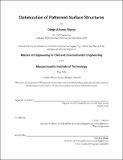Optimization of Patterned Surface Structures
Author(s)
Rivera, Diego Alfonso.
Download1192460915-MIT.pdf (47.74Mb)
Other Contributors
Massachusetts Institute of Technology. Department of Civil and Environmental Engineering.
Advisor
Caitlin T. Mueller.
Terms of use
Metadata
Show full item recordAbstract
This thesis advances a recent work on the optimization of patterned surface structures used for architecture and structural engineering. On their own, well-designed surface structures--such as plates and shells--can be highly efficient, but by introducing specific aperture patterns, designers can further improve their potential for structural efficiency. Used as a way to invigorate an otherwise homogeneous architectural environment, even intricately patterned surfaces with highly complex geometries can be realized thanks to recent advancements in digital fabrication technologies. Most recent work on the integration of pattern design and structural optimization lacks general structural engineering applicability and does not address the incompatibility of traditional analysis methods with contemporary CAD environments. This thesis, on the other hand, builds upon a method that employs the concept of isogcometric analysis to bridge the gap between CAD modeling and structural analysis and, in turn, lays the groundwork for structural pattern optimization in a more accessible computational environment. Initially introduced as a more systematic approach for exploring structural patterns, the studied method is further developed into a design workflow by the author of this thesis. Specifically, the presented research includes: adapting the previous method for more generic surface and pattern geometries, performing detailed parametric studies, and outlining an adaptive optimization framework more suitable for conceptual design exploration. The design workflow is tested on five design case studies, which demonstrate that while the studied methods can be utilized for high-resolution analysis, using an adaptive framework yields comparable results and can save designers significant computational time in the early stages of design. Implemented by the author in Rhinoceros3D and Crasshopper3D, this expanded framework for structural pattern optimization illuminates a new and accessible avenue for designing patterned surface structures. This research provides designers a new way to synthesize architectural creativity and computational rigor in the early stages of conceptual design and even paves way for future research to further develop it into a robust design tool that can help designers marry architectural objectives and structural performance.
Description
Thesis: M. Eng., Massachusetts Institute of Technology, Department of Civil and Environmental Engineering, May, 2020 Cataloged from the official PDF of thesis. "May 2020." Includes bibliographical references (pages 83-86).
Date issued
2020Department
Massachusetts Institute of Technology. Department of Civil and Environmental EngineeringPublisher
Massachusetts Institute of Technology
Keywords
Civil and Environmental Engineering.